Business Model Deconstruction Report: Reebok International Analysis
VerifiedAdded on 2022/09/01
|8
|2011
|27
Report
AI Summary
This report provides a comprehensive deconstruction of Reebok International's business model, employing the Business Model Canvas framework. It begins with an introduction to Reebok, its history, and its position in the sports equipment industry, highlighting its transition towards a fitness-focused brand. The analysis then meticulously examines each of the nine building blocks of the Business Model Canvas, including customer segments (targeting men, women, and kids with a focus on sports and fitness enthusiasts), value propositions (innovation, customization, and brand status), channels (direct and online sales, retail outlets, and e-commerce), customer relationships (self-service, online support, and loyalty programs), key activities (product design, development, and customer service), key partners (outsourced manufacturing and research collaborations), cost structures (value-driven with sales, administration, and marketing as key drivers), key resources (physical, online, and human resources), and revenue streams (product sales and license fees). The report further explores the interrelationships between these building blocks, identifies critical success factors such as pricing and brand image, and discusses factors impacting the success of the business model, including marketing, operational, and legal risks. Finally, the report suggests potential changes to the business model, such as expansion into developing nations and product innovation, to enhance Reebok's competitiveness and sustainability.

Running Head: MANAGEMENT 0
BUSINESS MODEL DECONSTRUCTION
BUSINESS MODEL DECONSTRUCTION
Paraphrase This Document
Need a fresh take? Get an instant paraphrase of this document with our AI Paraphraser
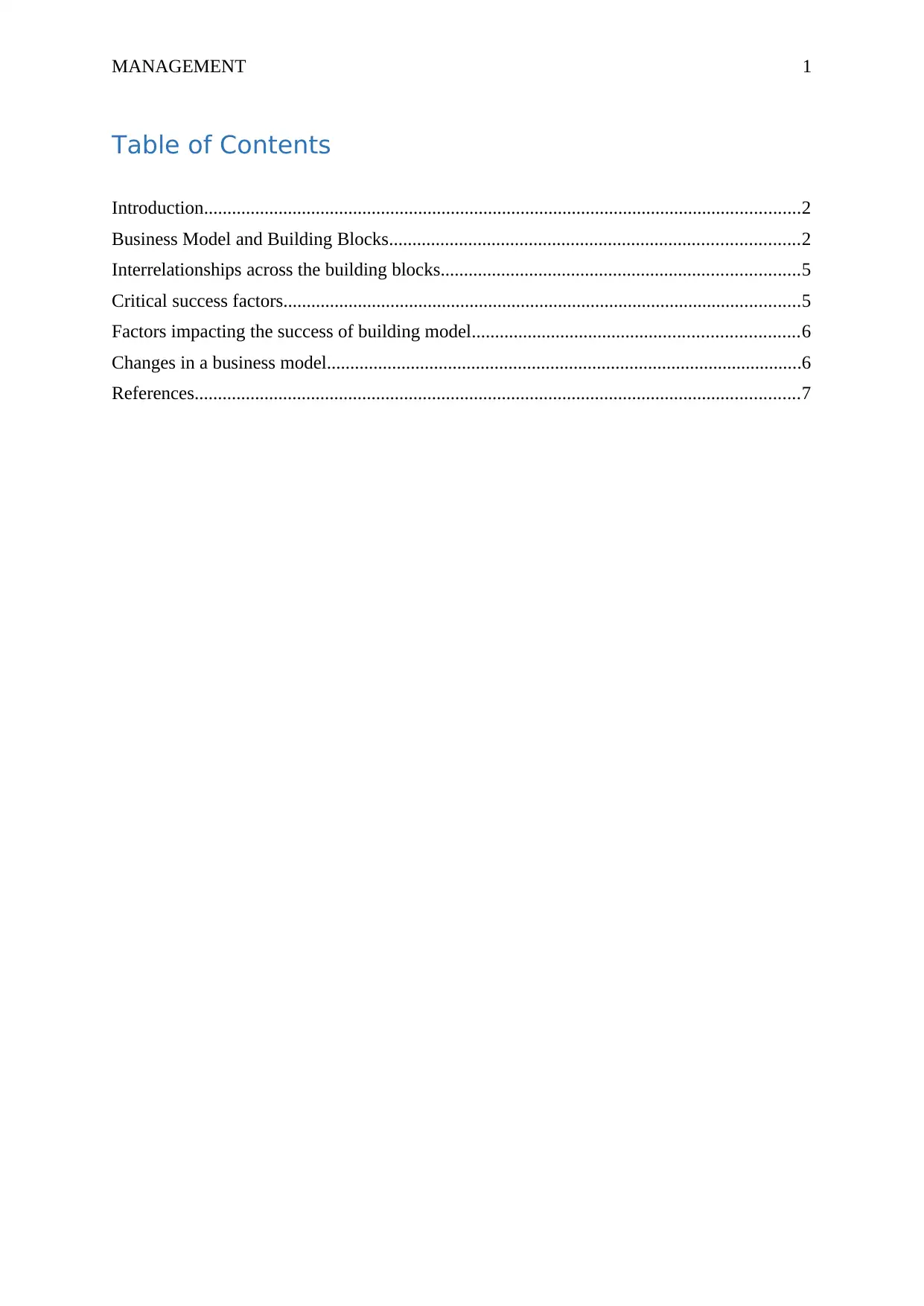
MANAGEMENT 1
Table of Contents
Introduction................................................................................................................................2
Business Model and Building Blocks........................................................................................2
Interrelationships across the building blocks.............................................................................5
Critical success factors...............................................................................................................5
Factors impacting the success of building model......................................................................6
Changes in a business model......................................................................................................6
References..................................................................................................................................7
Table of Contents
Introduction................................................................................................................................2
Business Model and Building Blocks........................................................................................2
Interrelationships across the building blocks.............................................................................5
Critical success factors...............................................................................................................5
Factors impacting the success of building model......................................................................6
Changes in a business model......................................................................................................6
References..................................................................................................................................7
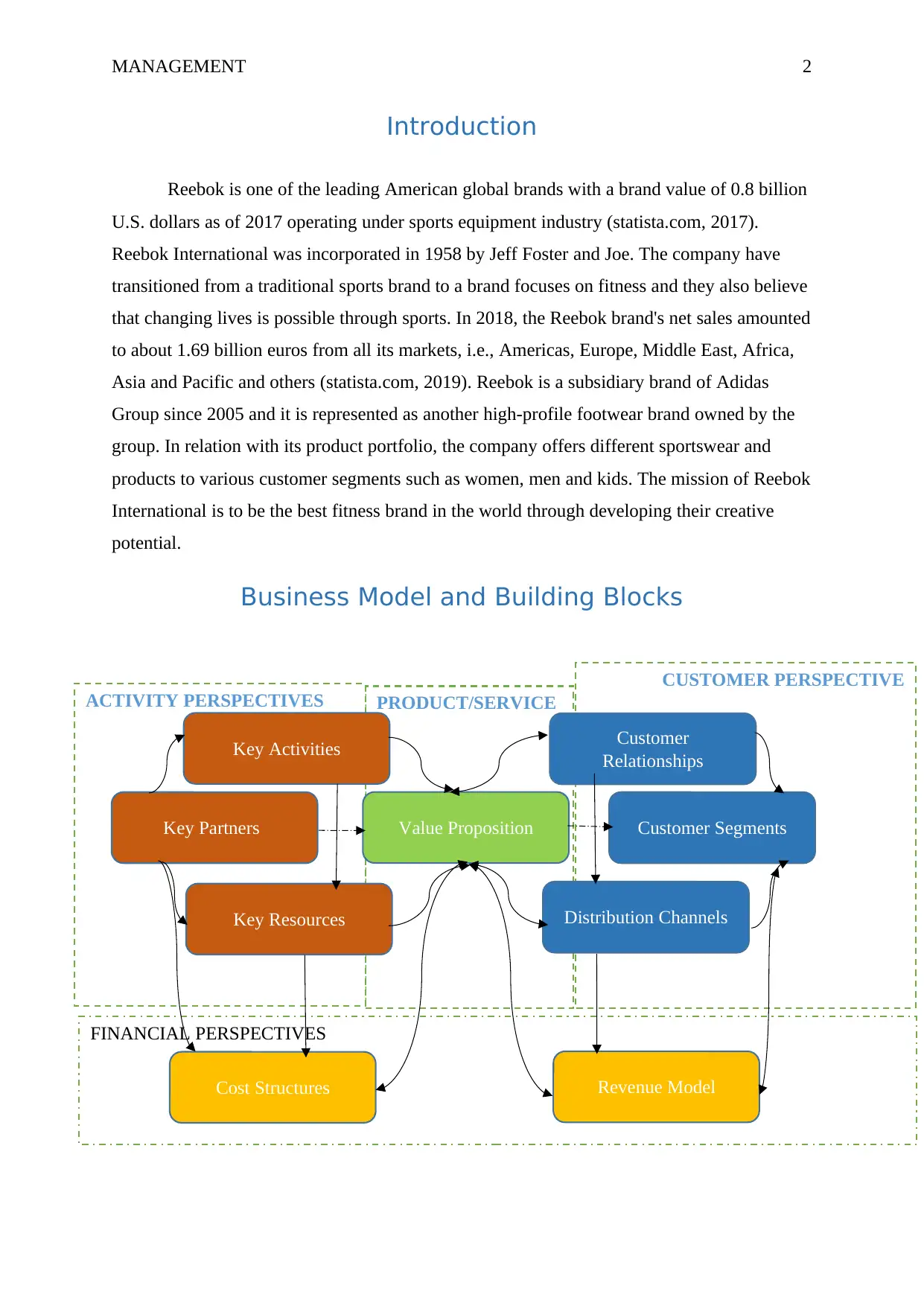
MANAGEMENT 2
Introduction
Reebok is one of the leading American global brands with a brand value of 0.8 billion
U.S. dollars as of 2017 operating under sports equipment industry (statista.com, 2017).
Reebok International was incorporated in 1958 by Jeff Foster and Joe. The company have
transitioned from a traditional sports brand to a brand focuses on fitness and they also believe
that changing lives is possible through sports. In 2018, the Reebok brand's net sales amounted
to about 1.69 billion euros from all its markets, i.e., Americas, Europe, Middle East, Africa,
Asia and Pacific and others (statista.com, 2019). Reebok is a subsidiary brand of Adidas
Group since 2005 and it is represented as another high-profile footwear brand owned by the
group. In relation with its product portfolio, the company offers different sportswear and
products to various customer segments such as women, men and kids. The mission of Reebok
International is to be the best fitness brand in the world through developing their creative
potential.
Business Model and Building Blocks
FINANCIAL PERSPECTIVES
CUSTOMER PERSPECTIVE
PRODUCT/SERVICEACTIVITY PERSPECTIVES
Key Activities
Key Partners
Key Resources
Value Proposition
Customer
Relationships
Customer Segments
Distribution Channels
Cost Structures Revenue Model
Introduction
Reebok is one of the leading American global brands with a brand value of 0.8 billion
U.S. dollars as of 2017 operating under sports equipment industry (statista.com, 2017).
Reebok International was incorporated in 1958 by Jeff Foster and Joe. The company have
transitioned from a traditional sports brand to a brand focuses on fitness and they also believe
that changing lives is possible through sports. In 2018, the Reebok brand's net sales amounted
to about 1.69 billion euros from all its markets, i.e., Americas, Europe, Middle East, Africa,
Asia and Pacific and others (statista.com, 2019). Reebok is a subsidiary brand of Adidas
Group since 2005 and it is represented as another high-profile footwear brand owned by the
group. In relation with its product portfolio, the company offers different sportswear and
products to various customer segments such as women, men and kids. The mission of Reebok
International is to be the best fitness brand in the world through developing their creative
potential.
Business Model and Building Blocks
FINANCIAL PERSPECTIVES
CUSTOMER PERSPECTIVE
PRODUCT/SERVICEACTIVITY PERSPECTIVES
Key Activities
Key Partners
Key Resources
Value Proposition
Customer
Relationships
Customer Segments
Distribution Channels
Cost Structures Revenue Model
⊘ This is a preview!⊘
Do you want full access?
Subscribe today to unlock all pages.

Trusted by 1+ million students worldwide
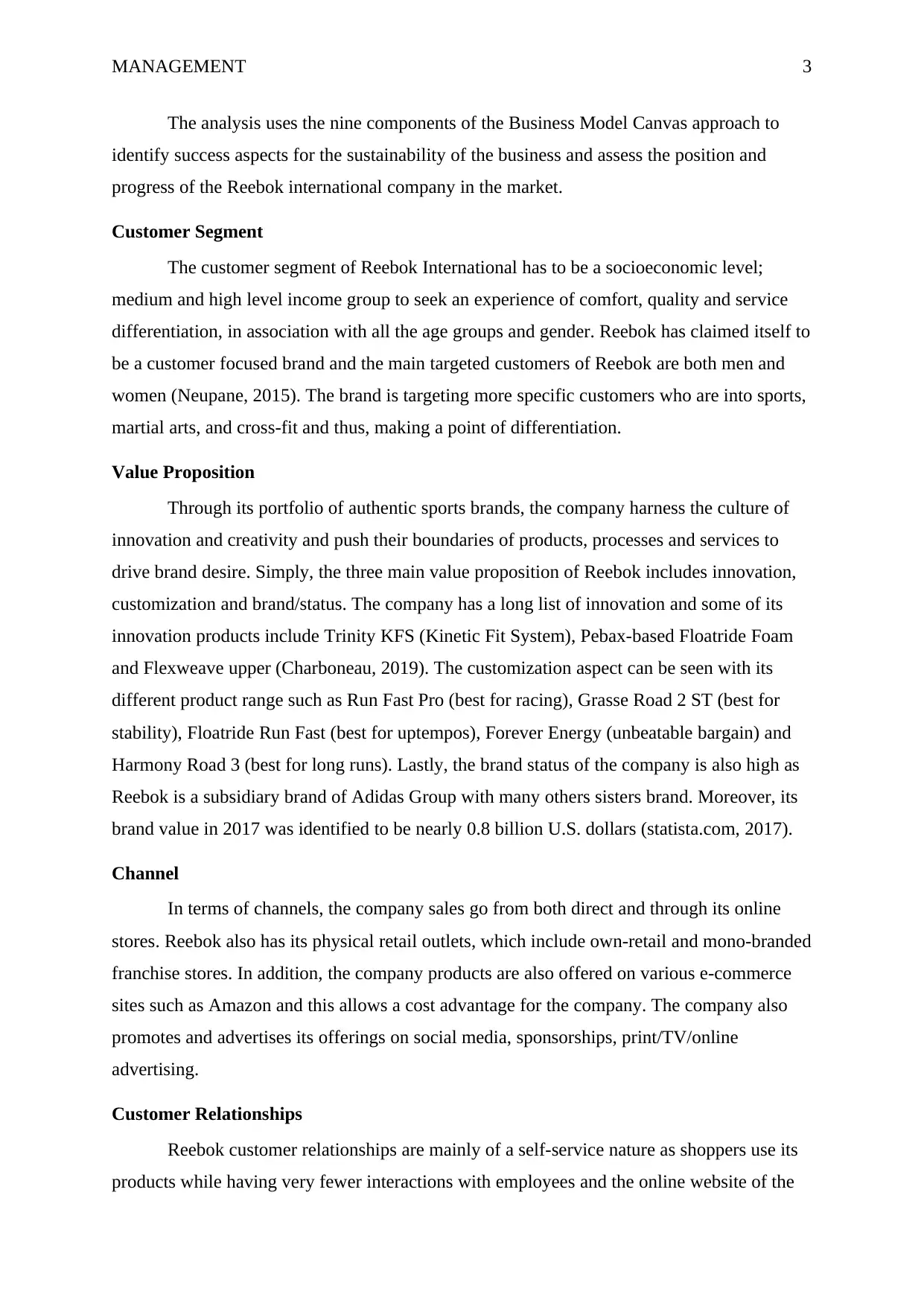
MANAGEMENT 3
The analysis uses the nine components of the Business Model Canvas approach to
identify success aspects for the sustainability of the business and assess the position and
progress of the Reebok international company in the market.
Customer Segment
The customer segment of Reebok International has to be a socioeconomic level;
medium and high level income group to seek an experience of comfort, quality and service
differentiation, in association with all the age groups and gender. Reebok has claimed itself to
be a customer focused brand and the main targeted customers of Reebok are both men and
women (Neupane, 2015). The brand is targeting more specific customers who are into sports,
martial arts, and cross-fit and thus, making a point of differentiation.
Value Proposition
Through its portfolio of authentic sports brands, the company harness the culture of
innovation and creativity and push their boundaries of products, processes and services to
drive brand desire. Simply, the three main value proposition of Reebok includes innovation,
customization and brand/status. The company has a long list of innovation and some of its
innovation products include Trinity KFS (Kinetic Fit System), Pebax-based Floatride Foam
and Flexweave upper (Charboneau, 2019). The customization aspect can be seen with its
different product range such as Run Fast Pro (best for racing), Grasse Road 2 ST (best for
stability), Floatride Run Fast (best for uptempos), Forever Energy (unbeatable bargain) and
Harmony Road 3 (best for long runs). Lastly, the brand status of the company is also high as
Reebok is a subsidiary brand of Adidas Group with many others sisters brand. Moreover, its
brand value in 2017 was identified to be nearly 0.8 billion U.S. dollars (statista.com, 2017).
Channel
In terms of channels, the company sales go from both direct and through its online
stores. Reebok also has its physical retail outlets, which include own-retail and mono-branded
franchise stores. In addition, the company products are also offered on various e-commerce
sites such as Amazon and this allows a cost advantage for the company. The company also
promotes and advertises its offerings on social media, sponsorships, print/TV/online
advertising.
Customer Relationships
Reebok customer relationships are mainly of a self-service nature as shoppers use its
products while having very fewer interactions with employees and the online website of the
The analysis uses the nine components of the Business Model Canvas approach to
identify success aspects for the sustainability of the business and assess the position and
progress of the Reebok international company in the market.
Customer Segment
The customer segment of Reebok International has to be a socioeconomic level;
medium and high level income group to seek an experience of comfort, quality and service
differentiation, in association with all the age groups and gender. Reebok has claimed itself to
be a customer focused brand and the main targeted customers of Reebok are both men and
women (Neupane, 2015). The brand is targeting more specific customers who are into sports,
martial arts, and cross-fit and thus, making a point of differentiation.
Value Proposition
Through its portfolio of authentic sports brands, the company harness the culture of
innovation and creativity and push their boundaries of products, processes and services to
drive brand desire. Simply, the three main value proposition of Reebok includes innovation,
customization and brand/status. The company has a long list of innovation and some of its
innovation products include Trinity KFS (Kinetic Fit System), Pebax-based Floatride Foam
and Flexweave upper (Charboneau, 2019). The customization aspect can be seen with its
different product range such as Run Fast Pro (best for racing), Grasse Road 2 ST (best for
stability), Floatride Run Fast (best for uptempos), Forever Energy (unbeatable bargain) and
Harmony Road 3 (best for long runs). Lastly, the brand status of the company is also high as
Reebok is a subsidiary brand of Adidas Group with many others sisters brand. Moreover, its
brand value in 2017 was identified to be nearly 0.8 billion U.S. dollars (statista.com, 2017).
Channel
In terms of channels, the company sales go from both direct and through its online
stores. Reebok also has its physical retail outlets, which include own-retail and mono-branded
franchise stores. In addition, the company products are also offered on various e-commerce
sites such as Amazon and this allows a cost advantage for the company. The company also
promotes and advertises its offerings on social media, sponsorships, print/TV/online
advertising.
Customer Relationships
Reebok customer relationships are mainly of a self-service nature as shoppers use its
products while having very fewer interactions with employees and the online website of the
Paraphrase This Document
Need a fresh take? Get an instant paraphrase of this document with our AI Paraphraser
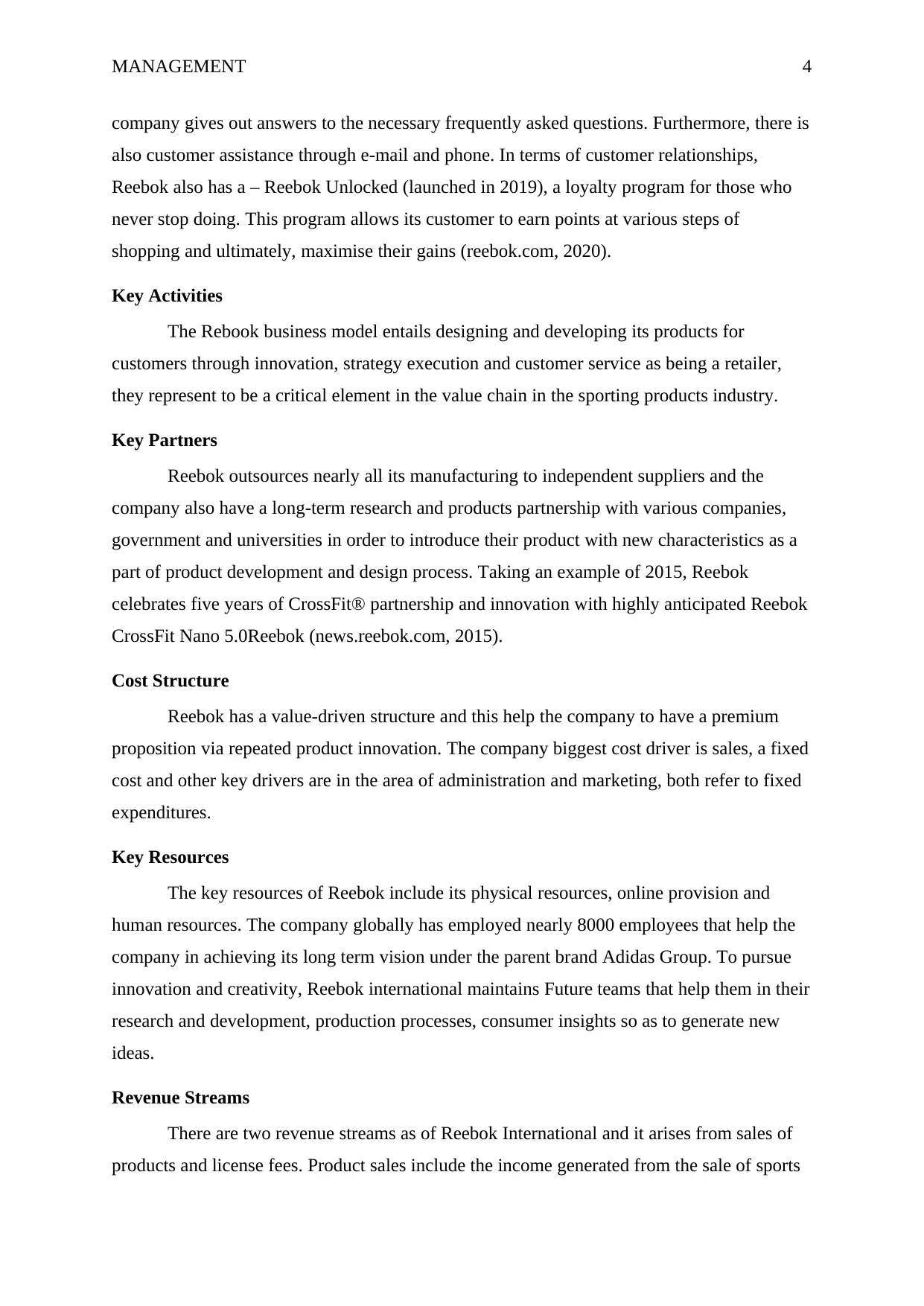
MANAGEMENT 4
company gives out answers to the necessary frequently asked questions. Furthermore, there is
also customer assistance through e-mail and phone. In terms of customer relationships,
Reebok also has a – Reebok Unlocked (launched in 2019), a loyalty program for those who
never stop doing. This program allows its customer to earn points at various steps of
shopping and ultimately, maximise their gains (reebok.com, 2020).
Key Activities
The Rebook business model entails designing and developing its products for
customers through innovation, strategy execution and customer service as being a retailer,
they represent to be a critical element in the value chain in the sporting products industry.
Key Partners
Reebok outsources nearly all its manufacturing to independent suppliers and the
company also have a long-term research and products partnership with various companies,
government and universities in order to introduce their product with new characteristics as a
part of product development and design process. Taking an example of 2015, Reebok
celebrates five years of CrossFit® partnership and innovation with highly anticipated Reebok
CrossFit Nano 5.0Reebok (news.reebok.com, 2015).
Cost Structure
Reebok has a value-driven structure and this help the company to have a premium
proposition via repeated product innovation. The company biggest cost driver is sales, a fixed
cost and other key drivers are in the area of administration and marketing, both refer to fixed
expenditures.
Key Resources
The key resources of Reebok include its physical resources, online provision and
human resources. The company globally has employed nearly 8000 employees that help the
company in achieving its long term vision under the parent brand Adidas Group. To pursue
innovation and creativity, Reebok international maintains Future teams that help them in their
research and development, production processes, consumer insights so as to generate new
ideas.
Revenue Streams
There are two revenue streams as of Reebok International and it arises from sales of
products and license fees. Product sales include the income generated from the sale of sports
company gives out answers to the necessary frequently asked questions. Furthermore, there is
also customer assistance through e-mail and phone. In terms of customer relationships,
Reebok also has a – Reebok Unlocked (launched in 2019), a loyalty program for those who
never stop doing. This program allows its customer to earn points at various steps of
shopping and ultimately, maximise their gains (reebok.com, 2020).
Key Activities
The Rebook business model entails designing and developing its products for
customers through innovation, strategy execution and customer service as being a retailer,
they represent to be a critical element in the value chain in the sporting products industry.
Key Partners
Reebok outsources nearly all its manufacturing to independent suppliers and the
company also have a long-term research and products partnership with various companies,
government and universities in order to introduce their product with new characteristics as a
part of product development and design process. Taking an example of 2015, Reebok
celebrates five years of CrossFit® partnership and innovation with highly anticipated Reebok
CrossFit Nano 5.0Reebok (news.reebok.com, 2015).
Cost Structure
Reebok has a value-driven structure and this help the company to have a premium
proposition via repeated product innovation. The company biggest cost driver is sales, a fixed
cost and other key drivers are in the area of administration and marketing, both refer to fixed
expenditures.
Key Resources
The key resources of Reebok include its physical resources, online provision and
human resources. The company globally has employed nearly 8000 employees that help the
company in achieving its long term vision under the parent brand Adidas Group. To pursue
innovation and creativity, Reebok international maintains Future teams that help them in their
research and development, production processes, consumer insights so as to generate new
ideas.
Revenue Streams
There are two revenue streams as of Reebok International and it arises from sales of
products and license fees. Product sales include the income generated from the sale of sports
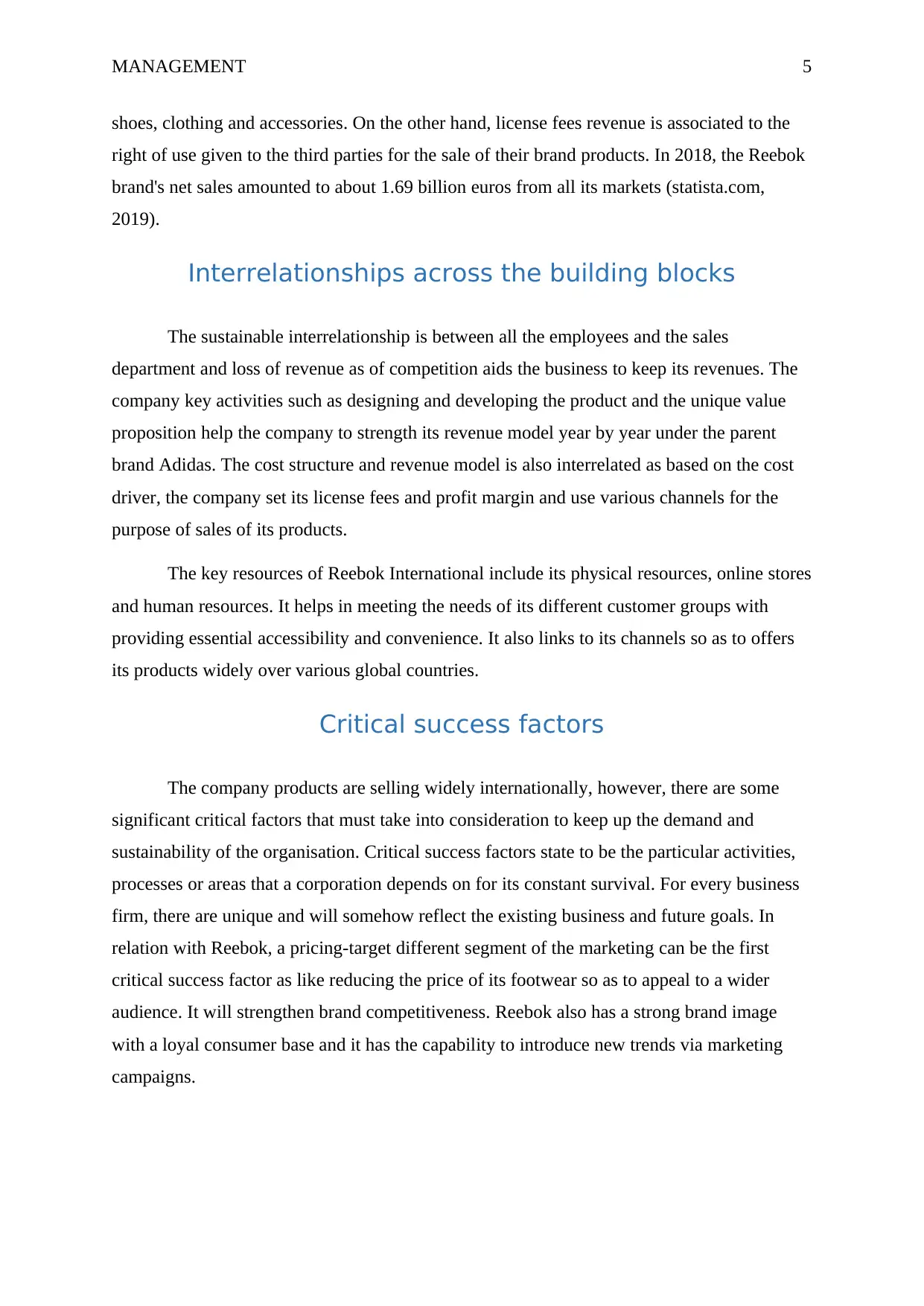
MANAGEMENT 5
shoes, clothing and accessories. On the other hand, license fees revenue is associated to the
right of use given to the third parties for the sale of their brand products. In 2018, the Reebok
brand's net sales amounted to about 1.69 billion euros from all its markets (statista.com,
2019).
Interrelationships across the building blocks
The sustainable interrelationship is between all the employees and the sales
department and loss of revenue as of competition aids the business to keep its revenues. The
company key activities such as designing and developing the product and the unique value
proposition help the company to strength its revenue model year by year under the parent
brand Adidas. The cost structure and revenue model is also interrelated as based on the cost
driver, the company set its license fees and profit margin and use various channels for the
purpose of sales of its products.
The key resources of Reebok International include its physical resources, online stores
and human resources. It helps in meeting the needs of its different customer groups with
providing essential accessibility and convenience. It also links to its channels so as to offers
its products widely over various global countries.
Critical success factors
The company products are selling widely internationally, however, there are some
significant critical factors that must take into consideration to keep up the demand and
sustainability of the organisation. Critical success factors state to be the particular activities,
processes or areas that a corporation depends on for its constant survival. For every business
firm, there are unique and will somehow reflect the existing business and future goals. In
relation with Reebok, a pricing-target different segment of the marketing can be the first
critical success factor as like reducing the price of its footwear so as to appeal to a wider
audience. It will strengthen brand competitiveness. Reebok also has a strong brand image
with a loyal consumer base and it has the capability to introduce new trends via marketing
campaigns.
shoes, clothing and accessories. On the other hand, license fees revenue is associated to the
right of use given to the third parties for the sale of their brand products. In 2018, the Reebok
brand's net sales amounted to about 1.69 billion euros from all its markets (statista.com,
2019).
Interrelationships across the building blocks
The sustainable interrelationship is between all the employees and the sales
department and loss of revenue as of competition aids the business to keep its revenues. The
company key activities such as designing and developing the product and the unique value
proposition help the company to strength its revenue model year by year under the parent
brand Adidas. The cost structure and revenue model is also interrelated as based on the cost
driver, the company set its license fees and profit margin and use various channels for the
purpose of sales of its products.
The key resources of Reebok International include its physical resources, online stores
and human resources. It helps in meeting the needs of its different customer groups with
providing essential accessibility and convenience. It also links to its channels so as to offers
its products widely over various global countries.
Critical success factors
The company products are selling widely internationally, however, there are some
significant critical factors that must take into consideration to keep up the demand and
sustainability of the organisation. Critical success factors state to be the particular activities,
processes or areas that a corporation depends on for its constant survival. For every business
firm, there are unique and will somehow reflect the existing business and future goals. In
relation with Reebok, a pricing-target different segment of the marketing can be the first
critical success factor as like reducing the price of its footwear so as to appeal to a wider
audience. It will strengthen brand competitiveness. Reebok also has a strong brand image
with a loyal consumer base and it has the capability to introduce new trends via marketing
campaigns.
⊘ This is a preview!⊘
Do you want full access?
Subscribe today to unlock all pages.

Trusted by 1+ million students worldwide
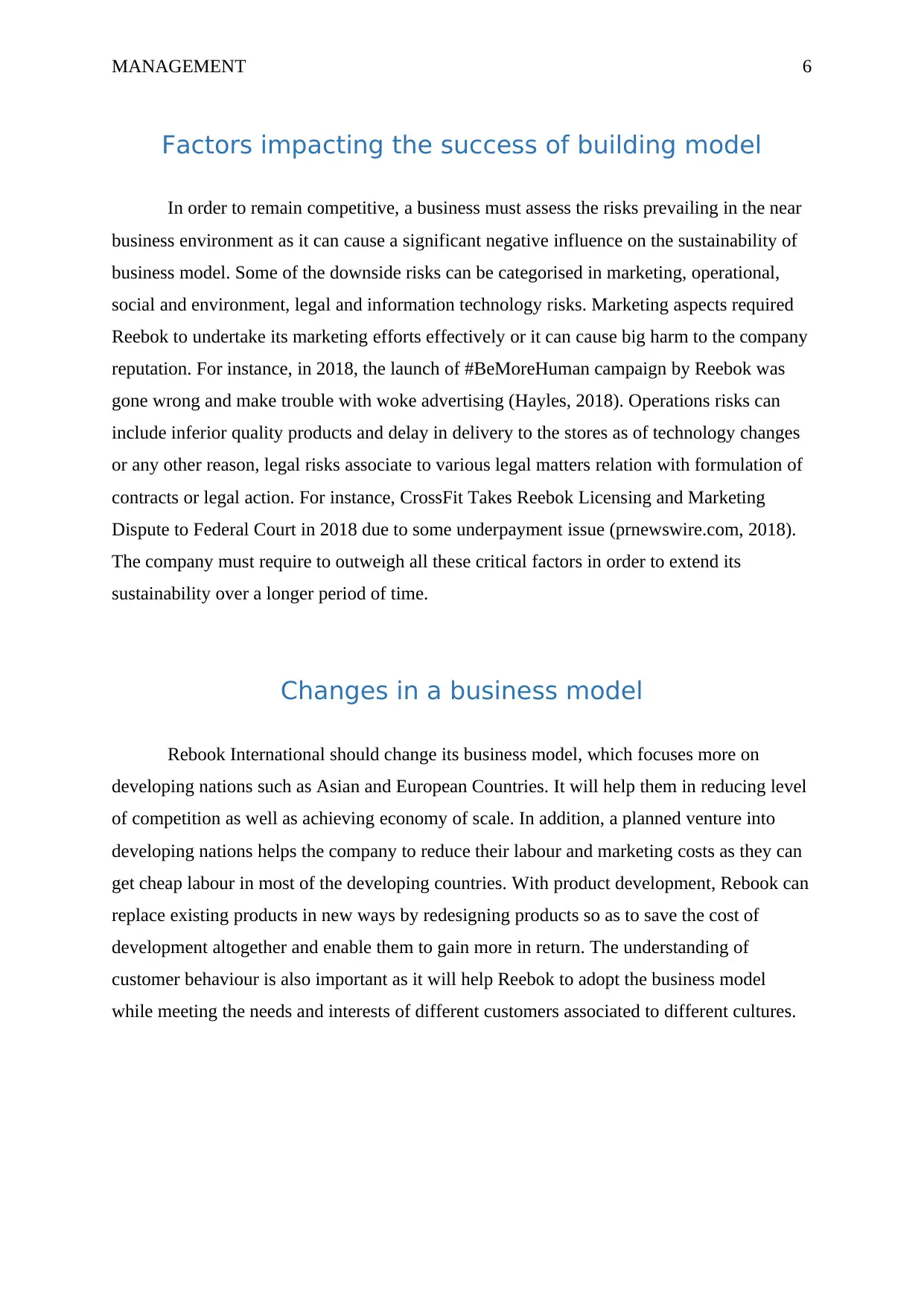
MANAGEMENT 6
Factors impacting the success of building model
In order to remain competitive, a business must assess the risks prevailing in the near
business environment as it can cause a significant negative influence on the sustainability of
business model. Some of the downside risks can be categorised in marketing, operational,
social and environment, legal and information technology risks. Marketing aspects required
Reebok to undertake its marketing efforts effectively or it can cause big harm to the company
reputation. For instance, in 2018, the launch of #BeMoreHuman campaign by Reebok was
gone wrong and make trouble with woke advertising (Hayles, 2018). Operations risks can
include inferior quality products and delay in delivery to the stores as of technology changes
or any other reason, legal risks associate to various legal matters relation with formulation of
contracts or legal action. For instance, CrossFit Takes Reebok Licensing and Marketing
Dispute to Federal Court in 2018 due to some underpayment issue (prnewswire.com, 2018).
The company must require to outweigh all these critical factors in order to extend its
sustainability over a longer period of time.
Changes in a business model
Rebook International should change its business model, which focuses more on
developing nations such as Asian and European Countries. It will help them in reducing level
of competition as well as achieving economy of scale. In addition, a planned venture into
developing nations helps the company to reduce their labour and marketing costs as they can
get cheap labour in most of the developing countries. With product development, Rebook can
replace existing products in new ways by redesigning products so as to save the cost of
development altogether and enable them to gain more in return. The understanding of
customer behaviour is also important as it will help Reebok to adopt the business model
while meeting the needs and interests of different customers associated to different cultures.
Factors impacting the success of building model
In order to remain competitive, a business must assess the risks prevailing in the near
business environment as it can cause a significant negative influence on the sustainability of
business model. Some of the downside risks can be categorised in marketing, operational,
social and environment, legal and information technology risks. Marketing aspects required
Reebok to undertake its marketing efforts effectively or it can cause big harm to the company
reputation. For instance, in 2018, the launch of #BeMoreHuman campaign by Reebok was
gone wrong and make trouble with woke advertising (Hayles, 2018). Operations risks can
include inferior quality products and delay in delivery to the stores as of technology changes
or any other reason, legal risks associate to various legal matters relation with formulation of
contracts or legal action. For instance, CrossFit Takes Reebok Licensing and Marketing
Dispute to Federal Court in 2018 due to some underpayment issue (prnewswire.com, 2018).
The company must require to outweigh all these critical factors in order to extend its
sustainability over a longer period of time.
Changes in a business model
Rebook International should change its business model, which focuses more on
developing nations such as Asian and European Countries. It will help them in reducing level
of competition as well as achieving economy of scale. In addition, a planned venture into
developing nations helps the company to reduce their labour and marketing costs as they can
get cheap labour in most of the developing countries. With product development, Rebook can
replace existing products in new ways by redesigning products so as to save the cost of
development altogether and enable them to gain more in return. The understanding of
customer behaviour is also important as it will help Reebok to adopt the business model
while meeting the needs and interests of different customers associated to different cultures.
Paraphrase This Document
Need a fresh take? Get an instant paraphrase of this document with our AI Paraphraser
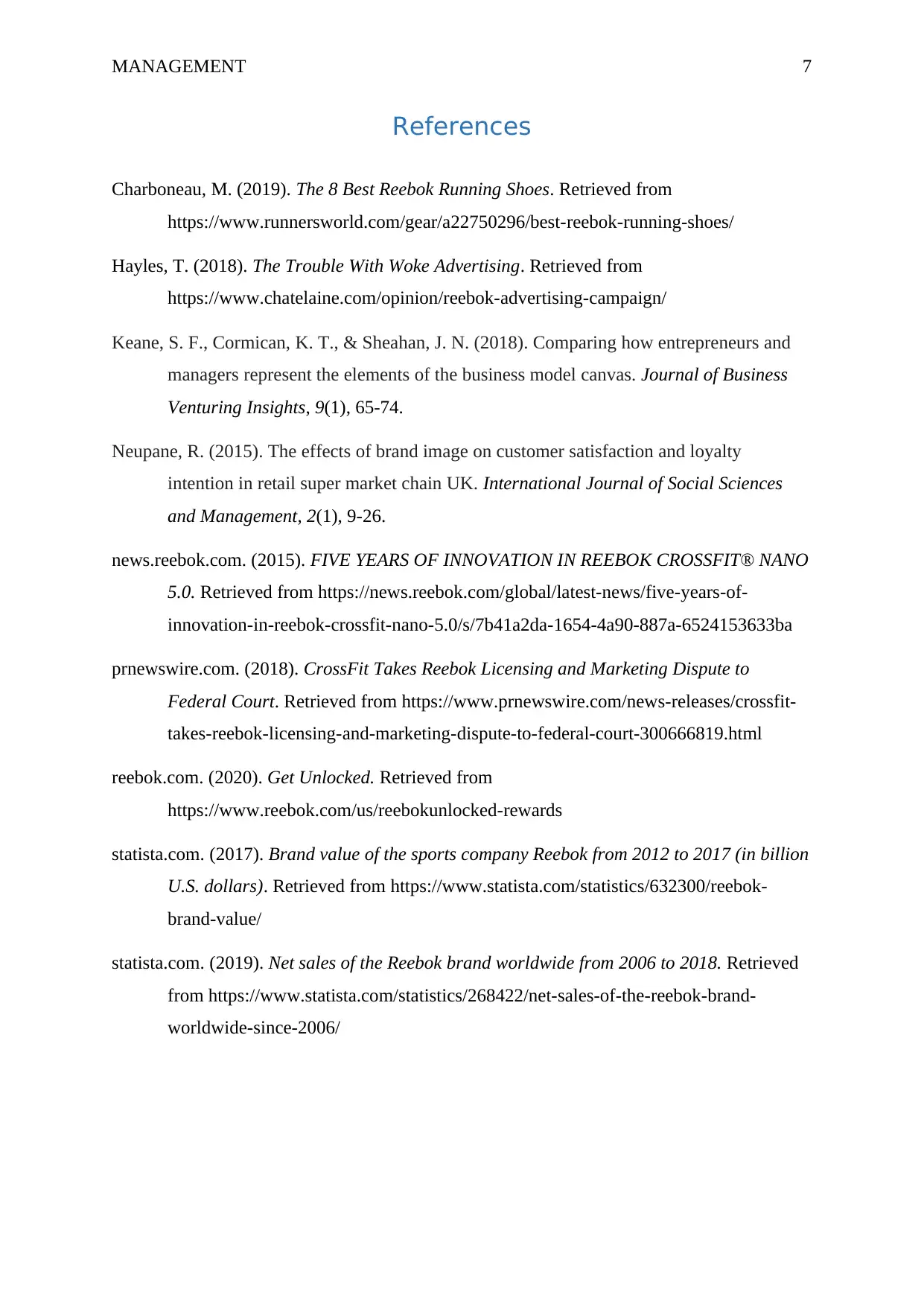
MANAGEMENT 7
References
Charboneau, M. (2019). The 8 Best Reebok Running Shoes. Retrieved from
https://www.runnersworld.com/gear/a22750296/best-reebok-running-shoes/
Hayles, T. (2018). The Trouble With Woke Advertising. Retrieved from
https://www.chatelaine.com/opinion/reebok-advertising-campaign/
Keane, S. F., Cormican, K. T., & Sheahan, J. N. (2018). Comparing how entrepreneurs and
managers represent the elements of the business model canvas. Journal of Business
Venturing Insights, 9(1), 65-74.
Neupane, R. (2015). The effects of brand image on customer satisfaction and loyalty
intention in retail super market chain UK. International Journal of Social Sciences
and Management, 2(1), 9-26.
news.reebok.com. (2015). FIVE YEARS OF INNOVATION IN REEBOK CROSSFIT® NANO
5.0. Retrieved from https://news.reebok.com/global/latest-news/five-years-of-
innovation-in-reebok-crossfit-nano-5.0/s/7b41a2da-1654-4a90-887a-6524153633ba
prnewswire.com. (2018). CrossFit Takes Reebok Licensing and Marketing Dispute to
Federal Court. Retrieved from https://www.prnewswire.com/news-releases/crossfit-
takes-reebok-licensing-and-marketing-dispute-to-federal-court-300666819.html
reebok.com. (2020). Get Unlocked. Retrieved from
https://www.reebok.com/us/reebokunlocked-rewards
statista.com. (2017). Brand value of the sports company Reebok from 2012 to 2017 (in billion
U.S. dollars). Retrieved from https://www.statista.com/statistics/632300/reebok-
brand-value/
statista.com. (2019). Net sales of the Reebok brand worldwide from 2006 to 2018. Retrieved
from https://www.statista.com/statistics/268422/net-sales-of-the-reebok-brand-
worldwide-since-2006/
References
Charboneau, M. (2019). The 8 Best Reebok Running Shoes. Retrieved from
https://www.runnersworld.com/gear/a22750296/best-reebok-running-shoes/
Hayles, T. (2018). The Trouble With Woke Advertising. Retrieved from
https://www.chatelaine.com/opinion/reebok-advertising-campaign/
Keane, S. F., Cormican, K. T., & Sheahan, J. N. (2018). Comparing how entrepreneurs and
managers represent the elements of the business model canvas. Journal of Business
Venturing Insights, 9(1), 65-74.
Neupane, R. (2015). The effects of brand image on customer satisfaction and loyalty
intention in retail super market chain UK. International Journal of Social Sciences
and Management, 2(1), 9-26.
news.reebok.com. (2015). FIVE YEARS OF INNOVATION IN REEBOK CROSSFIT® NANO
5.0. Retrieved from https://news.reebok.com/global/latest-news/five-years-of-
innovation-in-reebok-crossfit-nano-5.0/s/7b41a2da-1654-4a90-887a-6524153633ba
prnewswire.com. (2018). CrossFit Takes Reebok Licensing and Marketing Dispute to
Federal Court. Retrieved from https://www.prnewswire.com/news-releases/crossfit-
takes-reebok-licensing-and-marketing-dispute-to-federal-court-300666819.html
reebok.com. (2020). Get Unlocked. Retrieved from
https://www.reebok.com/us/reebokunlocked-rewards
statista.com. (2017). Brand value of the sports company Reebok from 2012 to 2017 (in billion
U.S. dollars). Retrieved from https://www.statista.com/statistics/632300/reebok-
brand-value/
statista.com. (2019). Net sales of the Reebok brand worldwide from 2006 to 2018. Retrieved
from https://www.statista.com/statistics/268422/net-sales-of-the-reebok-brand-
worldwide-since-2006/
1 out of 8
Related Documents
Your All-in-One AI-Powered Toolkit for Academic Success.
+13062052269
info@desklib.com
Available 24*7 on WhatsApp / Email
![[object Object]](/_next/static/media/star-bottom.7253800d.svg)
Unlock your academic potential
Copyright © 2020–2025 A2Z Services. All Rights Reserved. Developed and managed by ZUCOL.




